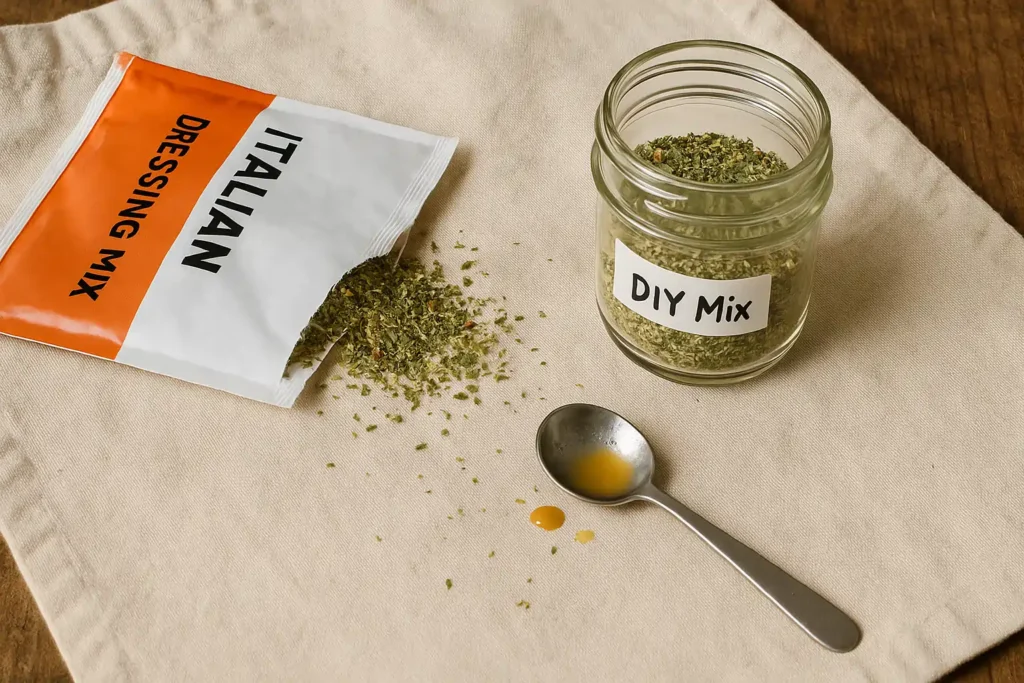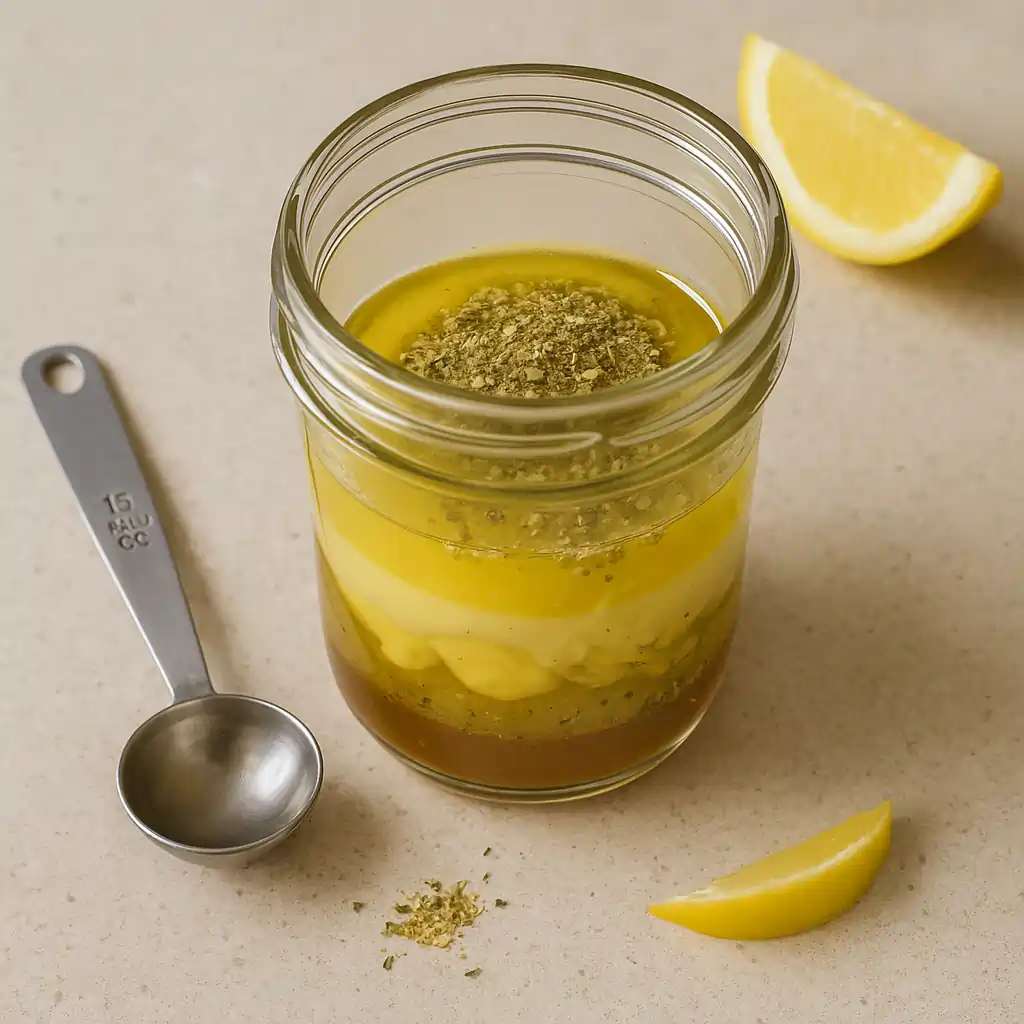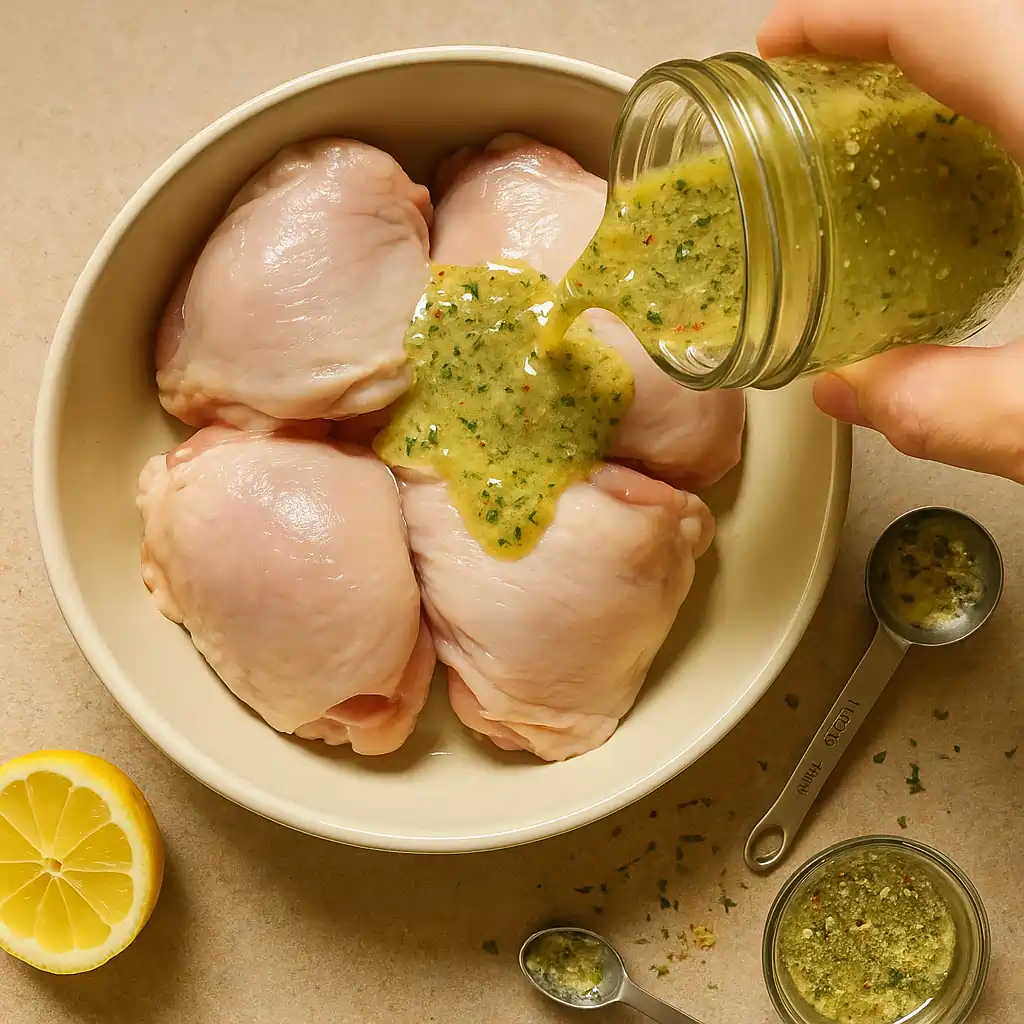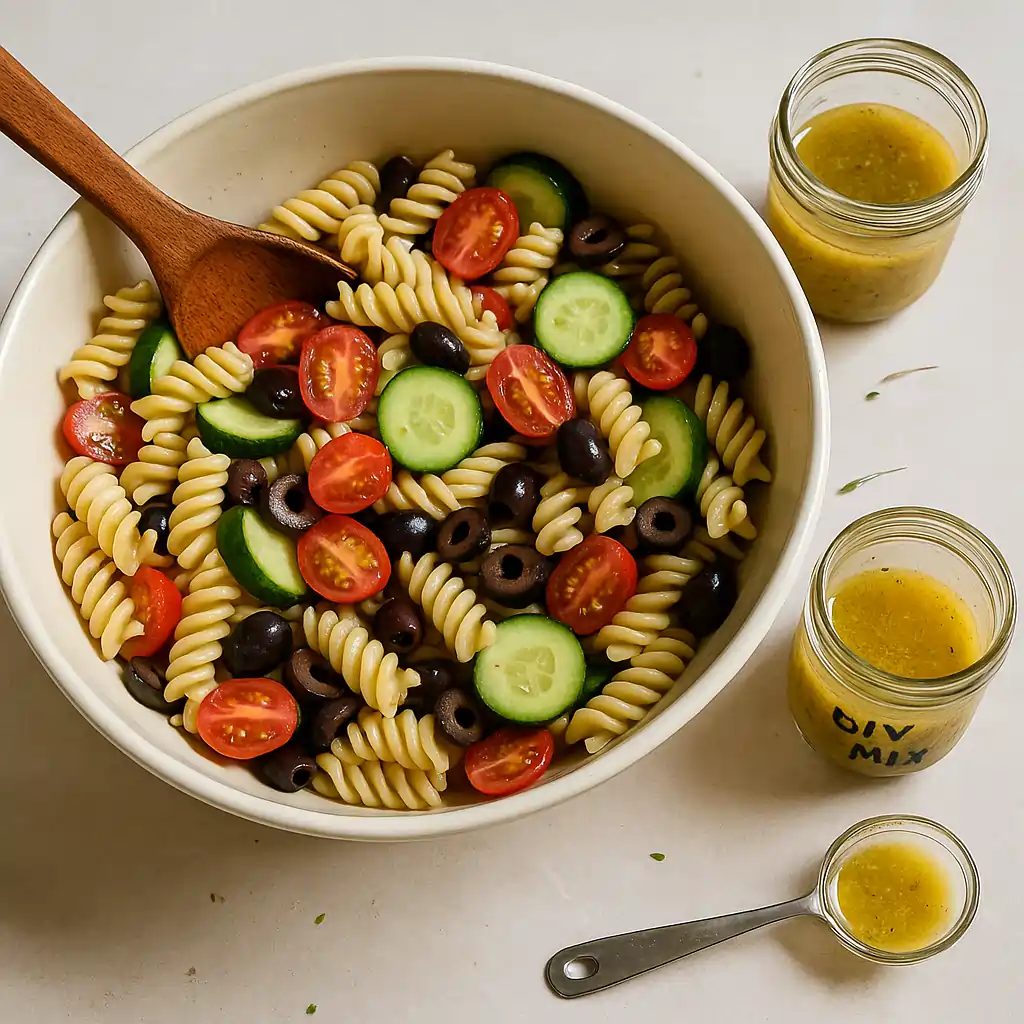I used to swear by those little packets until one exploded in my tote and perfumed everything I owned like oregano. That was my breaking point. I built a DIY Italian salad dressing mix that tastes brighter, costs less, and lives on my shelf without any mystery stuff.
The best part is control. I dial the herbs for the season, run low-sodium when I need to, and shake up fresh dressing in under a minute. Once you learn the liquid ratio, it’s a superpower—salads, marinades, pasta salads, all of it.

Table of Contents
Table of Contents
Why dry mix
A dry mix is flavor insurance. The herbs stay stable, the spice balance never changes, and you only add oil, vinegar, and water when it’s go-time. It’s also cheaper than single-use packets and you won’t get that weird “powdery sweetness” some brands sneak in.
I like the consistency. One scoop equals one batch, so weeknight-me doesn’t have to measure twelve things while hangry. And because it’s dry, you can rub it straight on chicken or veg before roasting, which feels like cheating but it’s just planning.
My first blend was chaos—too much garlic powder, tasted dusty. The fix was simple: crush the hard herbs so they wake up, lean on oregano and basil, and keep mustard powder for body. Suddenly it tasted like the Italian dressing I actually wanted, not a salt lick.
Spice blend formula (make-ahead jar)

This makes about ¾ cup of mix, enough for 6–8 salads. Use a clean, dry jar and shake to combine. Lightly crush the leafy herbs and the rosemary between fingers so they’re fragrant, not powder.
Italian Salad Dressing Mix
Equipment
- airtight jar
- measuring spoons
- small funnel (optional)
- mixing bowl (if not shaking directly in jar)
- label for jar
Ingredients
- 3 tbsp dried oregano
- 2 tbsp dried basil
- 1 tbsp dried parsley
- 1 tbsp garlic powder
- 2 tsp onion powder
- 2 tsp dried thyme
- 1.5 tsp mustard powder
- 1 tsp crushed red pepper flakes
- 1 tsp freshly ground black pepper
- 1 tsp celery seed, lightly crushed
- 1 tsp paprika (sweet or smoked)
- 1 tsp kosher salt (optional)
- 0.5 tsp dried rosemary, crushed
Instructions
- In a clean, dry jar, combine all the dry ingredients listed. Lightly crush the leafy herbs and rosemary between your fingers to release aroma. Shake well to blend.
- To make dressing: Mix 2 tablespoons of the dry mix with ¼ cup red wine vinegar, ½ cup olive oil, 2 tablespoons cold water, and 1 teaspoon Dijon mustard in a jar. Shake for 20 seconds until glossy.
- For a marinade: Use 1 tablespoon mix with 2 tablespoons oil and 2 tablespoons vinegar per 1 lb of protein. Marinate for 30 minutes to 2 hours depending on ingredient.
- Store dry mix in an airtight jar away from light and heat. Keeps for 6–12 months depending on spice freshness.
- Optional low-sodium tweaks: Omit salt in mix, add lemon zest or nutritional yeast when preparing dressing. Taste on lettuce and adjust if needed.
Notes
- Skip the salt for a low-sodium version and add lemon zest or nutritional yeast for punch.
- Swap in balsamic or apple cider vinegar for a twist.
- Add honey or maple if a bit of sweetness is desired.
Flavor notes, learned the hard way. Mustard powder helps the eventual dressing emulsify, so don’t skip it. Celery seed is small but mighty; crush it a little so it blooms and doesn’t read “pickly.” If your garlic powder is sharp, blend half-and-half with granulated to smooth the bite.
How to use (liquid ratios, quick dressing, marinade)

Here’s the house ratio for classic Italian vinaigrette. It’s shake-jar easy, and yes, water is part of the plan because it lightens texture and helps it cling.
Add to a jar: 2 tablespoons Italian Salad Dressing Mix, ¼ cup red wine vinegar, ½ cup extra-virgin olive oil or avocado oil, 2 tablespoons cold water, and 1 teaspoon Dijon. Seal and shake hard for 20 seconds until glossy. Taste on a lettuce leaf—never just the spoon.
Too sharp. Add 1 tablespoon water before more oil.
Too flat. Squeeze a little lemon or add a pinch more mix and shake again.
Needs a hint of sweet. ½–1 teaspoon honey or maple will round the edges without turning it into dessert.
For pasta salad, I run the same ratio but reserve 2 tablespoons of dressing to toss in right before serving, so it tastes fresh. For a quick pizza-salad vibe, swap half the red wine vinegar for balsamic, then finish with cracked pepper at the table.
Marinade math is simple. Whisk 1 tablespoon mix with 2 tablespoons oil and 2 tablespoons vinegar per 1 pound chicken, shrimp, or veg. Thirty minutes for shrimp, 30–60 minutes for chicken thighs or zucchini, up to 2 hours for sturdier cuts. Acid is bossy—don’t go all day or it starts changing texture in a way you won’t love.
Low-sodium option (big flavor, tiny numbers)

Salt in a dry mix is convenient, but optional. I usually skip it and season to taste in the liquid step, which keeps the jar flexible for everyone at the table. If you need punch without salt, stack aroma and acid.
Do this and it works. Add ½ teaspoon lemon zest to the jar when you shake the dressing, use a friendly acid like red wine vinegar plus a squeeze of fresh lemon, and finish with a crack of black pepper. A pinch of nutritional yeast in the liquid (about ¼ teaspoon) adds warm, “savory” depth that reads like richness, not salt.
If your mustard runs salty, switch to a low-sodium Dijon or use ½ teaspoon instead of a full teaspoon. And taste on a leaf before adding salt—it’s wild how often herbs and acid do the heavy lifting by themselves. If sodium’s your main project right now, I mapped out more tricks over at Low Sodium Salad Dressing (No-Salt Added, Big Flavor) and the master ratio guide at My Guide to Salad Dressing ties it all together.
Storage (airtight, away from light)
Air, heat, and light are the enemies. Keep the dry mix in an airtight jar in a dark cupboard, not above the stove. It’s best for about 6 months for peak aroma, good up to 12 months if your spices were fresh to start.
Clumping happens in humid kitchens. Tap the jar and shake to loosen before scooping. I don’t toss in rice or silica packs because it’s a food jar; I just keep a small, dry spoon inside and never measure over steaming pots. Learned that one after perfuming a whole batch with pasta vapor. Oops.
For the liquid dressing, store it in the fridge 1–2 weeks if it’s just oil, vinegar, water, and dry spices. If you add fresh garlic, herbs, or Parmesan, plan to finish in 3–5 days. Oil may firm up when cold—warm the jar in your hands or under lukewarm water, then shake until glossy again.
Label printout idea (ready-to-stick text)
I print this on a 2×3 label and slap it on the jar. Future-me is grateful, and so is anyone I gift it to.
Italian Salad Dressing Mix (DIY)
Dry mix: Oregano, basil, parsley, garlic powder, onion powder, thyme, mustard powder, red pepper, black pepper, celery seed, paprika, salt (optional), crushed rosemary.
Use: 2 Tbsp mix + ¼ cup red wine vinegar + ½ cup olive oil + 2 Tbsp water + 1 tsp Dijon. Shake 20 sec. Taste on a leaf; adjust with water for sharpness, lemon for lift.
Marinade: 1 Tbsp mix + 2 Tbsp oil + 2 Tbsp vinegar per 1 lb protein; 30–120 min.
Low-sodium: Omit salt; add lemon zest in jar.
If you want a sweeter, cozy riff, swap in balsamic for half the vinegar and give it a tiny drizzle of honey. For a brighter ACV vibe, use apple cider vinegar and peek at /apple-cider-vinegar-salad-dressing/ for more tricks. Sugar-free crowds can skip the honey and use the balance moves from /sugar-free-salad-dressing/; it plugs right in.
Wrap-up
Once this mix is on your shelf, weeknight salads stop feeling like chores. Scoop, shake, taste, tweak, done. It beats the packet on price, on flavor, and honestly on pride, because you know exactly what’s inside.
If you’re building out your dressing library, the master guide at /salad-dressing/ has ratios, storage tips, and fixes for common flops. Pair this mix with the ideas in /low-sodium-salad-dressing/ and /sugar-free-salad-dressing/ when you want focused nutrition, or run the ACV lane with /apple-cider-vinegar-salad-dressing/ for a softer tang. Drop your tweaks in the comments—I’m always stealing good ideas for my next jar.
